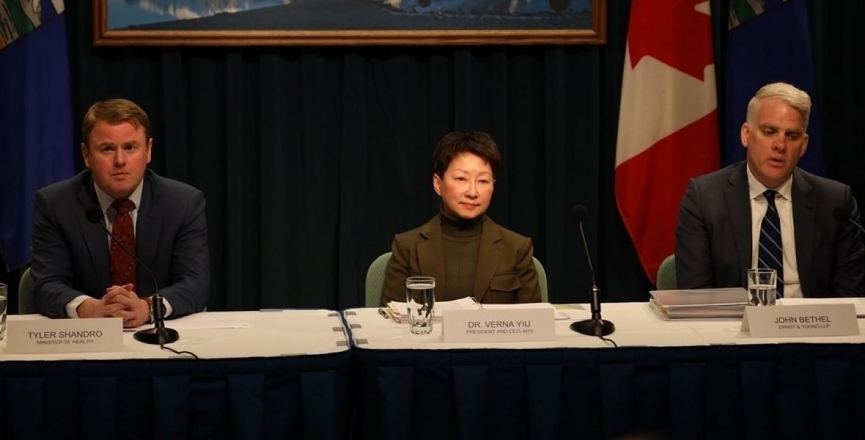Does anyone remember the $2-million “review” of Alberta Health Services by Ernst & Young launched a year ago by the United Conservative Party government?
Health Minister Tyler Shandro and Alberta Health Services president and CEO Verna Yiu were both on hand to ensure we understood it was an important matter when the initial report of the multinational management-consulting firm based in London, England, was released on February 3 this year.
The report recommended a broad swath of health-care privatization, pay cuts and asset sales that would supposedly save the government of Alberta up to nearly $2 billion a year.
Quoting discredited sources like the Fraser Institute, Ernst & Young delivered what the government that hired it had clearly wanted: 57 recommendations including privatization of many surgical services, elimination of coverage for others, pay and benefit cuts for public health-care workers, and a selloff of publicly owned assets.
In other words, the usual neoliberal mayhem designed to finance huge tax cuts for foreign corporations and local billionaires while degrading public services to the point even more privatization can be justified.
Among the recommended “long-term strategies” on the consultant’s list was elimination of support for surgical “procedures of limited value.” Upon examination, quite a few of these turned out to be “procedures of value to women.” This should have been no surprise, really, given the worldview of the UCP and its leader, Premier Jason Kenney.
Privatization targets included hospital housekeeping, food preparation, security, home care, and — most significantly — the sell-off of two large public long-term care providers, Capital Care in Edmonton and Carewest in Calgary.
The government didn’t like every idea Ernst & Young came up with, however. It rejected out of hand the suggestion AHS should close or repurpose many rural hospitals, among the biggest cost items in Alberta’s health care budget. This too was no surprise given the addresses of many of the UCP’s most reliable voters.
The government announced on February 3 that AHS would have 100 days to figure out how “to develop a comprehensive implementation plan that will be submitted to the Minister of Health for approval.”
That time was up yesterday, although no announcement was forthcoming.
Well, something has obviously changed since February — the arrival on our shores of a teeny-tiny virus that causes huge problems wherever it goes. There’s talk the requirement for AHS to produce its plan has been delayed until mid-August, perhaps while the government polls frantically to see what it can still get away with.
If ever there was a time to come to our senses and recognize that privatization of health-care services, in particular public-sector long-term care, is a bad idea, this is that moment!
The COVID-19 catastrophe in Alberta’s and Canada’s private, for-profit nursing homes alone tells you everything you need to know about the wisdom of this idea.
The COVID-19 death rate across Canada in private long-term care facilities is reported to be roughly four times the rate in public facilities. Alberta has had its share of these needless deaths, which can be traced back to corporate cost cutting and irresponsible, ideologically motivated policy decisions.
“Nowhere has the contrast between public and private care been starker than in our continuing care system,” said Alberta Union of Provincial Employees vice-president Bonnie Gostola in a news release yesterday. “We need the government to make it clear that they will not sell off Capital Care and Carewest. The focus of our continuing-care system needs to be on residents, not shareholder dividends and bonuses for millionaire CEOs.”
She noted that of the 35 COVID-19 outbreaks in supportive-living and long-term-care facilities in Alberta, only six have occurred in publicly run facilities. Private facilities make up the remaining 29 centres affected, 83 per cent of the continuing care outbreaks.
“In the 100 days since this report has been released, we’ve had a clear case made for keeping our health care system public,” Gostola said. “Patients and workers deserve better than to have our system sold off to profiteers. We cannot put vulnerable people at risk of inferior private care after we make it through this pandemic.”
Of course, it would be naïve to think the most ideological Alberta government since William Aberhart’s Social Credit government was elected in 1935 is going to change its tune, although it may not whistle its discordant notes quite so loudly as it used to before the coronavirus arrived in Canada.
Indeed, even the Socreds, after they’d calmed down once Ernest Manning became premier in 1943, sensibly banned private-sector nursing homes.
The UCP may delay for a while, perhaps even until after the next election. But don’t expect anything to change but the timing of the announcements.
Then again, these are guys who don’t mind fighting an all-out war on doctors in the middle of a global pandemic.
What they do next probably depends on how strong the public reaction is.
David Climenhaga, author of the Alberta Diary blog, is a journalist, author, journalism teacher, poet and trade union communicator who has worked in senior writing and editing positions at The Globe and Mail and the Calgary Herald. This post also appears on his blog, AlbertaPolitics.ca.
Image: Government of Alberta




